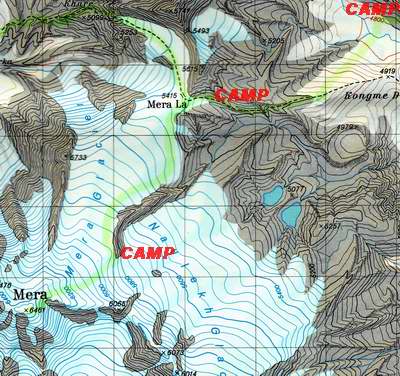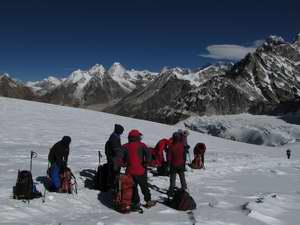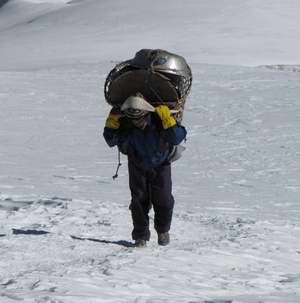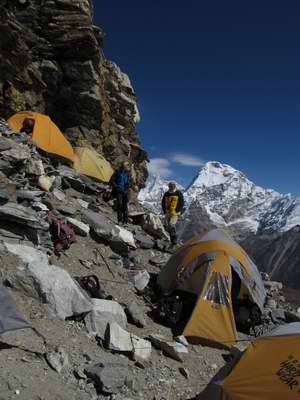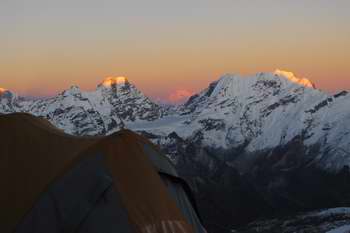Bed tea was brought round at
01.00, and we were supposed to be ready
for the off at 02.00, having had our breakfast, brought to the tent.
There was a crush at the edge of the ice with the Iranians having got
there just before us, and confusion reigned in the dark - it being
difficult to spot other members of the group when they are enveloped in
down jackets and helmets. I got my crampons on, eventually, but mislaid
one of my gloves in the process. There was no time to look for it, as
the sirdar had grabbed me and attached me to a rope, so I put on one of
my spare gloves. I had no idea who else was on the rope, or where the
rest of the group were - all I could see was a line of lights ahead and
I assumed I was at the back of a very long rope.
Shortly after starting, at around 02.15, we overtook a group, and then
some more, and it gradually became evident that I was on a rope of only
three of the group (Tish, Geoff and myself) with two sherpas. Ahead of
us we could only see a couple of individual lights, presumably sherpas
heading up to set up fixed ropes.
The ascent, after a short easy section, was steep and interminable. I
concentrated on the feet of the person ahead, and the limited range of
the headlamp meant that I had little awareness of my surroundings,
although I did see one crevasse as we passed. It was another fabulously
starry night, cold but not extreme. There were occasional fearsome
gusts of wind, sometimes with spindrift, but it was generally a gentle
wind.
We did a steady plod, but at that altitude it was like doing a
marathon. I tried to imagine, from our views of the route on previous
days, where we were - but the reality seemed much longer, the plodding
just went on and on. Luckily we had frequent stops.
|
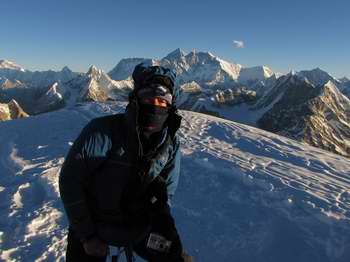
Tish on the summit of Mera Peak
|
|
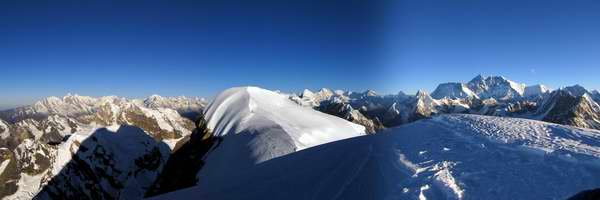
|
Eventually dawn came and the
shape of the mountain gradually became clear - but not the route up,
which came as a surprise. After a short level section we came to a
fixed safety rope which we followed to the base of a small ice cliff
about 5m high, with a crevasse below. Here we had to jumar up. After
this vertical section there was a merely steep section which very
rapidly brought us to the sloping summit ridge.
Made it! And it was only 06.30!
There were fabulous views of Everest and its neighbours, Makalu
and Kanchenjunga. Down to the south in deep shadow we could see the
Hinku valley we had walked up days ago.
After a short while we were joined by Tony, George and Karin - who
provided us with a celebratory tot of Talisker. After a few more
photographs we turned to go down, just in time to see John being helped
up the final steep section (a miracle, as John had been very ill in the
days before), followed by Keith - so eight of us had made it to the top.
|
We learned later that Margaret
had had a bad night and had not set off with us, and that the four
others had turned back on the way up having almost reached the fixed
rope section.
We then had to queue to abseil back down before setting off at a
cracking pace, sort of on autopilot, to descend the same way back to
the remains of high camp for soup and squash - very welcome liquid.
After a short beak we headed off again to the Mera La base camp,
reaching it just before 11.00. Tiredness had really set in and it was a
relief to meet up with the rest of the group and have lunch - although
I had no appetite and a slight headache - wasn't that supposed to
happen at the top, and improve on descending?
We set off again just before 12.00 to descend to a camp about 400m
lower. The trail started off over dusty, gravelly, and rocky moraine
ground. Gradually we reached grassy terrain - but with not a hint of
green - with brown dried up grass and sedges. At 13.30 we reached the
camp site on the flat valley bottom - a total of just over 11 hours
after setting off in the dark |
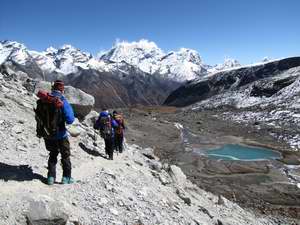
Descending from Mera La base camp
|
|
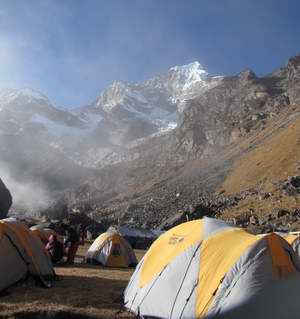
Camp site with drifting cloud
|
|
Tea was served at 15.00,
followed by warm washing water - so we were able to have a more
thorough clean-up than in the last few days! The temperature dropped as
cloud began swirling up the valley. Dinner at 18.00 was a short affair
as we were all tired; conversation was very brief before we gratefully
collapsed into our multi-layered sleeping bags.
|
Tuesday 27 October - into the wilderness
|
|
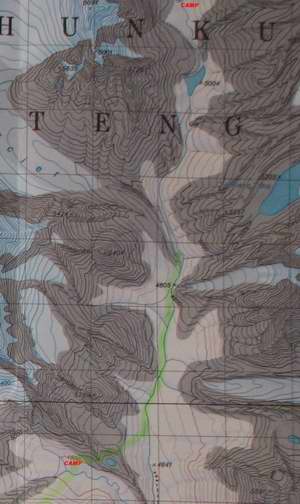
|
We breakfasted at 07.00 and I
felt great, no trace of a headache. I felt even better to find that
Biri was serving us scrambled egg on toast instead of the usual
hard-boiled egg. We set off down the valley for a short while
before climbing up over a moraine and passing a small lake trapped
between two moraines. We then descended into the main Hunku valley.
There was no trace of a trail on the map and only sporadic evidence on
the ground.
|
All day we were in the close
company of moraines - climbing up over
them, walking below them, or picking our way through the debris washed
down from them. Some moraines were incredibly high; a very impressive
one came down from the Hunku Teng glacier, virtually cutting off the
Hunku valley. There were so many piles of rocks of different types and
ages that it was difficult to work out the chronology of the formation
of the landscape. It wasn't just rocks either as fine glacier dust was
in the air - we had been advised to cover our faces to protect us when
breathing, and beside one shrunken lake we walked through very fine
sand, neatly rippled by either the wind or the water.
The whole valley was covered by dried brown grass, sedges and dead
flowers - probably an effect of the cold, rather than lack of water (as
there seemed to be plenty of that about, albeit often frozen). The only
green colour came from algae in some of the slow flowing streams and
peaty areas we passed through.
Ahead of us we got another view of Everest,with its banner cloud, and
Lhotse.
|
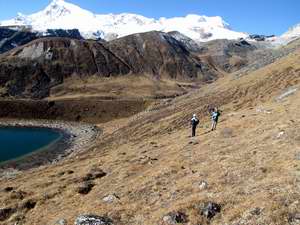
Leaving the Mera Peak area
|
|
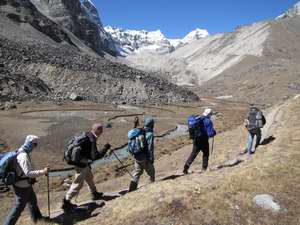
Trekking up the Hunku valley
|
|
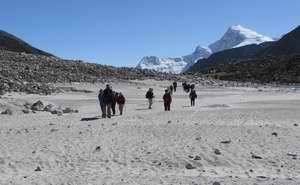
Crossing the sandy dried up fringe of a lake
|
|
We arrived in the camp at 14.38
and were quickly served with our afternoon tea (as well as tea we had
biscuits which we liberally spread with marmite, peanut butter or
honey). The sun went down rapidly as we were in a north-south valley
with high sides. Once darkness fell I spotted the Pole star and the
Little Bear for the first time on the trip - previously they had been
obscured by the mountains. The number of starts visible during the
night sorties was declining, however, as the size of the moon grew.
|
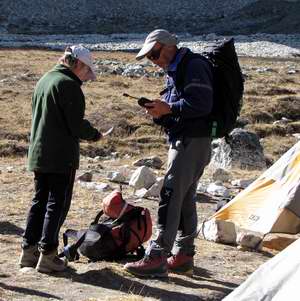
George and Margaret get to grips with the satellite
phone
|
|
Back
to
top
|
|
Previous log
|
Next Log
|
